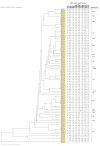Diversity of Mycobacterium tuberculosis genotypes circulating in Ndola, Zambia
- PMID: 20565802
- PMCID: PMC2906459
- DOI: 10.1186/1471-2334-10-177
Diversity of Mycobacterium tuberculosis genotypes circulating in Ndola, Zambia
Abstract
Background: Tuberculosis (TB) is one of the major public health problems in Zambia. However, information about lineages of M. tuberculosis complex (MTBC) isolates useful for epidemiology investigations is unknown. In this study, we investigated the diversity of MTBC isolates from Ndola, a typical Zambian urbanized city with a documented high HIV prevalence.
Methods: This was part of a prospective cohort study in subjects with sputum smear-positive pulmonary TB. Spoligotyping was used to genotype the MTBC isolates and establish the circulating lineages. The 15-locus Mycobacterial Interspersed Repetitive Units - Variable Number Tandem Repeats (MIRU-VNTR) typing was used to study recent transmission.
Results: A total of 98 different spoligotypes were identified among 273 MTBC isolates. The majority (64.8%) of the isolates belonged to 9 known families, while 96 (35.2%) of the isolates were orphans. While LAM (41.8%) was the largest spoligotype family observed, most of the isolates (87.7%) belonging to the SAF1 family, with a significant portion coming from the T (13.6%), and X (5.9%) families. A few isolates (3.6%) belonged to the CAS, EAI, H, S, X1-LAM9 or U families. MIRU-VNTR typing was highly discriminatory (h = 0.988) among the 156 isolates tested in our sample, and increased the discrimination among 82 SAF1 isolates from 6 to 46 distinct patterns. In addition, 3.2% (5/156) of cases with available MIRU-VNTR results harbored more than one MTBC strain.
Conclusions: Our findings show a limited diversity of MTBC in Ndola with a high clustering rate (37.7%), which indicates that recent transmission plays an appreciable role in the dynamics of TB disease in this setting. This conclusion emphasizes the importance of early diagnosis and timely treatment. The results also confirm that MIRU-VNTR typing is suitable for studying the molecular epidemiology of TB in Ndola.
Figures



Similar articles
-
Genetic Diversity of Mycobacterium tuberculosis Isolates from Assam, India: Dominance of Beijing Family and Discovery of Two New Clades Related to CAS1_Delhi and EAI Family Based on Spoligotyping and MIRU-VNTR Typing.PLoS One. 2015 Dec 23;10(12):e0145860. doi: 10.1371/journal.pone.0145860. eCollection 2015. PLoS One. 2015. PMID: 26701129 Free PMC article.
-
Molecular Typing of Mycobacterium Tuberculosis Complex by 24-Locus Based MIRU-VNTR Typing in Conjunction with Spoligotyping to Assess Genetic Diversity of Strains Circulating in Morocco.PLoS One. 2015 Aug 18;10(8):e0135695. doi: 10.1371/journal.pone.0135695. eCollection 2015. PLoS One. 2015. PMID: 26285026 Free PMC article.
-
Molecular epidemiology of clinical Mycobacterium tuberculosis complex isolates in South Omo, Southern Ethiopia.BMC Infect Dis. 2020 Oct 13;20(1):750. doi: 10.1186/s12879-020-05394-9. BMC Infect Dis. 2020. PMID: 33050903 Free PMC article.
-
Molecular epidemiology of M. tuberculosis in Ethiopia: A systematic review and meta-analysis.Tuberculosis (Edinb). 2019 Sep;118:101858. doi: 10.1016/j.tube.2019.101858. Epub 2019 Aug 7. Tuberculosis (Edinb). 2019. PMID: 31430694 Free PMC article.
-
The Ontario universal typing of tuberculosis (OUT-TB) surveillance program--what it means to you.Can Respir J. 2010 May-Jun;17(3):e51-4. doi: 10.1155/2010/715202. Can Respir J. 2010. PMID: 20617215 Free PMC article. Review.
Cited by
-
Reduced transmission of Mycobacterium africanum compared to Mycobacterium tuberculosis in urban West Africa.Int J Infect Dis. 2018 Aug;73:30-42. doi: 10.1016/j.ijid.2018.05.014. Epub 2018 Jun 4. Int J Infect Dis. 2018. PMID: 29879521 Free PMC article.
-
Molecular epidemiology and genetic diversity of Mycobacterium tuberculosis complex in the Cross River State, Nigeria.Infect Genet Evol. 2012 Jun;12(4):671-7. doi: 10.1016/j.meegid.2011.08.011. Epub 2011 Aug 22. Infect Genet Evol. 2012. PMID: 21878397 Free PMC article.
-
Genetic diversity of Mycobacterium tuberculosis clinical isolates in Blantyre, Malawi.Heliyon. 2019 Oct 10;5(10):e02638. doi: 10.1016/j.heliyon.2019.e02638. eCollection 2019 Oct. Heliyon. 2019. PMID: 31667430 Free PMC article.
-
Molecular Strain Typing of Mycobacterium tuberculosis: a Review of Frequently Used Methods.J Korean Med Sci. 2016 Nov;31(11):1673-1683. doi: 10.3346/jkms.2016.31.11.1673. J Korean Med Sci. 2016. PMID: 27709842 Free PMC article. Review.
-
Predominant Mycobacterium tuberculosis Families and High Rates of Recent Transmission among New Cases Are Not Associated with Primary Multidrug Resistance in Lima, Peru.J Clin Microbiol. 2015 Jun;53(6):1854-63. doi: 10.1128/JCM.03585-14. Epub 2015 Mar 25. J Clin Microbiol. 2015. PMID: 25809979 Free PMC article.
References
-
- World Health Organization. Global Tuberculosis Control WHO Report. WHO/HTM/TB/2009.411, Geneva, Switzerland, WHO; 2009.
-
- Central Statistical Office (CSO), Ministry of Health (MOH), Tropical Diseases Research Centre (TDRC), University of Zambia (UNZA), and Macro International Inc. Zambia Demographic and Health Survey 2007. Calverton, Maryland, USA: CSO and Macro International Inc; 2009.
Publication types
MeSH terms
Substances
LinkOut - more resources
Full Text Sources

